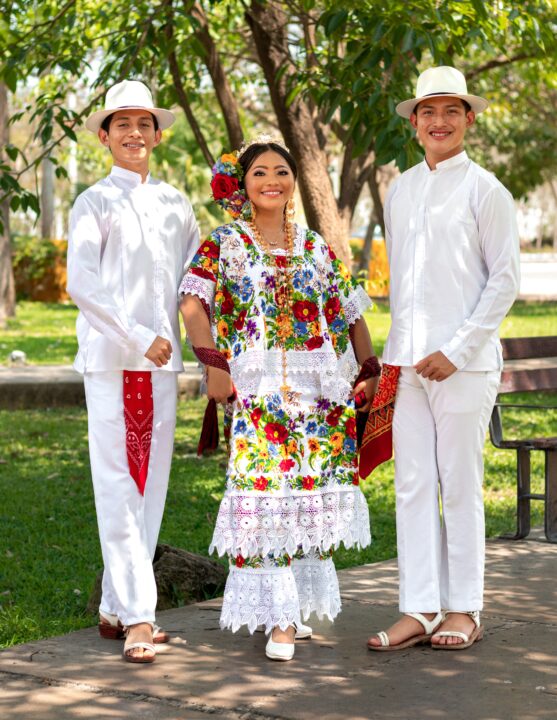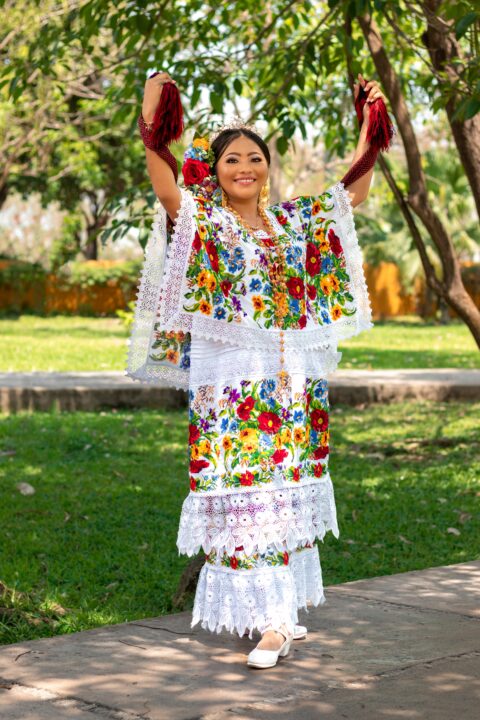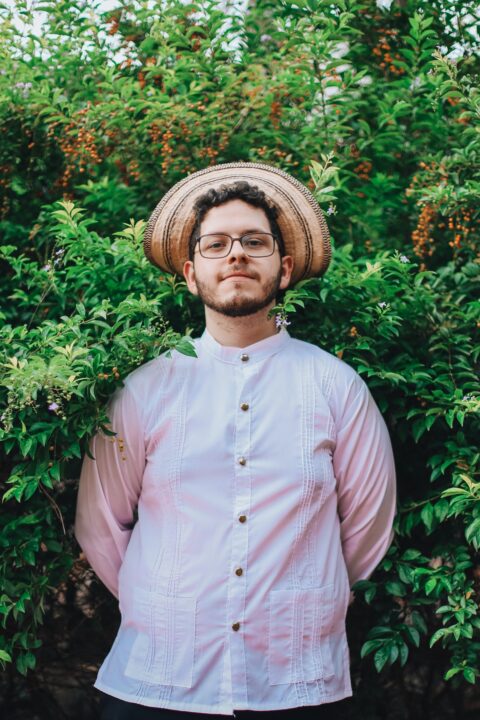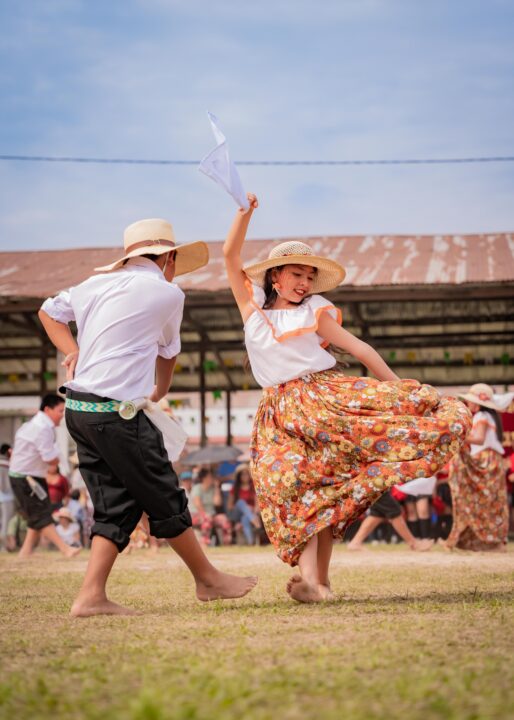Honduras is a thriving nation with a rich history and culture, as well as a diverse population, delectable cuisine, and traditional attire for its citizens. Their dress is not that dissimilar from others, reflecting customs from indigenous groups, the influence of countries nearby, immigration, as well as contemporary Western culture.
However, you might come across a whole distinctive fashion of Honduran traditional clothing in various areas of the nation. Regional and ethnic differences affect how Hondurans traditionally dress. The people of Garifuna, an Afro-Caribbean group residing in Honduras’ northern coastal regions, are recognized for wearing the country’s most well-known traditional attire.
A vivid cotton or satin skirt and a bandana or head scarf are popular accessories for women dressed in traditional Garifuna garb. Usually, there is bright lace or embroidery around the skirt’s hem. They also wear a white cotton top with a square neckline and puffy sleeves. For men, the typical attire consists of white or light-colored cotton slacks, a long-sleeved white cotton shirt, and a vibrant bandana or headscarf.
Other areas of Honduras may have traditional clothing that consists of skirts or ponchos made of geometrically patterned, vividly colored woven materials. Indigenous communities always embellish their garments with elaborate beadwork, embroidery, and patterns. For instance, the Lenca people are renowned for their hand-woven, vibrantly colored ponchos and skirts.
Honduran holidays and festivals are typically the only occasions when people dress traditionally. Although women in remote or Indigenous groups can prefer to wear more formal attire, bright, vibrant, and hand-stitched traditional attire can be found in Honduras. Men get dressed in white shirts and slacks with sombreros and bright red scarves, while women dress in long, sleeveless gowns with fabric belts.
Many Hondurans now dress in ways similar to those in the United States. Both male and female working professionals frequently don informal business attire, such as suits, blouses, heels, and dress shoes, in the cities. Let us familiarize ourselves with some of Honduras traditional clothing.
Types of Hondura Traditional Clothing
1. The Huipil
-

eduardo barrientos, pexels, 16654423.jpg
The Honduras traditional clothing is a reflection of the country’s diversified and rich past. The “huipil,” a blouse worn by ladies, is among the most popular examples of Honduran traditional clothing.
The huipil is a classic blouse that is often T-shaped. Huipils are primarily made of cotton or wool using a back-strap loom. One bar is linked to a stationary object, such as a tree or a piece of furniture, and the other bar is attached to the weaver using a strap around her back.
Embroidery, brocade, and tapestry techniques are frequently used to extensively adorn huipils. Because each huipil has its own unique colors and patterns, you can sometimes identify the region or even the village where it was first made. Huipils are typically worn by girls and women, though men have been known to wear them in certain regions. Depending on the Honduran region, the “huipil”‘s patterns can differ, and they frequently symbolize the wearer’s marital status or rank in society.
2. The Faja
The “faja,” a sash wrapped around the waist, is also part of Honduran traditional clothing. The “faja” is often crafted from vividly colored fabric and is frequently adorned with elaborate patterns. To complete the classic style, it is frequently worn with the “huipil”.
Women from rural villages make the faja as a kind of handmade art. At age 8, girls begin learning how to create them. Wood and waist looms are the two most commonly used methods for creating fajas. Each one’s designs and components are determined by the community’s ethnic, mythical, religious, and philosophical beliefs. The fajas serve as a means of identifying the community or group and shielding its members from negative energy. Additionally, dying skills are passed down from generation to generation.
3. The Cortes
-

rdne stock project, pexels, 8638933.jpg
In Honduras, women traditionally wear the “Cortes” outfit. Usually constructed out of breathable cotton or wool, the dress is long and falls to the ankles. The dress often has a waistband with a gathering and a flared skirt. The “Cortes” dress is typically embellished with vibrant embroidery or appliques and can be plain or patterned. Exquisite lace or ruffles are also found on some “Cortes” dresses.
In Honduras, “Cortes” clothing is revered as a cultural classic and a representation of the country’s identity. The attire is typically reserved for formal events like weddings and religious rituals. Additionally, it is used for folk dances like the “Toro Guarachero” dance. In many Honduran communities, this dance is practiced as part of the seasonal harvest festival. The “cortes” attire is a crucial component of the dance and is frequently embellished with flowers and ribbons.
In Honduras, “Cortes” clothing has a rich history that dates back to the early 19th century. The clothing was initially worn by native women in the Honduran highlands. The clothes of the Spanish invaders who landed in the area are thought to have had an impact on the “Cortes” clothing. The garment has changed over time and today it contains many different influences and designs. The “Cortes” costume is still a representation of Honduran culture and history.
4. The Guayabera
-

alejandra montenegro, pexels, 18184110.jpg
Originally from Cuba, the “guayabera” is a traditional shirt that is also used in Honduras and other nations in Latin America. In addition to having two rows of vertical pleats on the front, the “guayabera” often features four huge pockets. The typical fabric for the shirt is cotton or linen, and it is usually worn untucked. The “guayabera” can be worn both with and without a jacket, and it is frequently worn with “alpargatas,” which are canvas shoes similar to espadrilles.
The “guayabera” shirt has been around for decades and is thought to have started in the 18th century. The people who owned plantations and other affluent Cubans wore the clothing at first. But later, people from all classes started wearing the attire. The “guayabera” is a traditional dress used during festivals and other special occasions in Honduras. It is occasionally used as a dress shirt for a formal occasion. The “guayabera” has grown in popularity among tourists and famous people recently.
The “guayabera” shirt comes in a variety of styles. Some of these disparities are influenced by local fashions, while others are determined by the wearer’s preferences. Examples include “guayaberas” with long sleeves and those with short sleeves. The shirts come in a variety of hues and patterns, some being relatively plain and others rather ornate. Even some “guayaberas” come with unique embellishments like mother-of-pearl buttons or embroidered pockets. Whatever its variations, the “guayabera” continues to be cozy and fashionable.
5. The Sombrero
-

franklin santillan a, pexels, 17347270.jpg
Another classic item of Honduran traditional clothing is the “sombrero”. Farmers and other rural workers frequently don this broad-brimmed hat, which is generally constructed from palm leaves. Purchasing a “sombrero” is a common souvenir for visitors to Honduras. It is frequently embellished with vibrant ribbons and tassels, and on occasion, a “cacique,” or traditional feather headpiece, is added. In Honduran culture, wearing a “sombrero” is common for festivals and other special occasions.
6. The Aguayo waistcloth
Women in Honduras frequently wear an “aguayo” waist cloth, which is typically made of cotton or wool. To carry objects, such as food or babies, the “aguayo” is tied around the waist. In Honduras, it is also regarded as a representation of femininity and womanhood. “Aguayos,” come in a wide variety of patterns and styles; these unique patterns and styles are frequently passed down from one generation to the next.
The “aguayo” is a flexible outfit that can be worn in a number of ways. For instance, it can be used as a shawl, a skirt, or a baby carrier. Additionally, it can be used to keep warm in colder weather or shield the head from the sun. The “aguayo” can also be used as a blanket.
7. The Manta Shawl
Women in Honduras wear this as another piece of traditional clothing. The “manta” is a square or rectangle-shaped piece of clothing that is slung over the head or shoulders. It can be made of many different textiles, such as cotton, silk, or wool, and is frequently created in vibrant colors and patterns.
The “manta” is worn as a decorative item in addition to providing warmth. Many ladies in Honduras take great delight in their traditional “mantas” and choose their materials and patterns with great care.
An important aspect of Honduran traditional clothing and one with specific cultural significance is the “manta” shawl. For instance, it’s frequently worn at religious events and festivals. It is occasionally given to newlyweds as a wedding present. Additionally, the “manta” is frequently given as a gift to mark significant life occasions like a child’s birth or one’s graduation.
The “manta” shawl is significantly more than just a piece of cloth, as you can see. It has been incorporated into Honduras’ cultural heritage.
8. The Chumbo pants
Chumbe pants, or “pantalones chumbe,” are a very important part of Honduran traditional clothing. These are comfortable pants with a loose fit that are often made of cotton or wool. They are normally worn by men and are frequently embellished with vibrant embroidery. However, women may also don “chumbe” pants, particularly when performing physically demanding tasks. The “chumbe” pants are a useful and comfortable outfit that is frequently regarded as a representation of Honduran pride.
These trousers’ original wearers were the “chumbos,” or farmers, of northern Honduras, who gave rise to the style. The “chumbe” pants eventually spread throughout the entire country of Honduras and are now regarded as a national emblem. The pants are frequently linked to the nation’s agricultural heritage and ties to the land.
9. The Tzute apron
The “tzute” apron is a piece of clothing that is worn across the front of the body. It frequently features a vibrant and detailed design and is usually made from lightweight cotton or linen. Women typically wear the “tzute,” which has several functions. It can be used for carrying small items, shielding garments from stains and grime, or simply adding a splash of color to an item of clothing.
Historically significant to Honduran culture, the “tzute” is a remarkably adaptable piece of clothing. It has been utilized by indigenous women in the nation for many centuries and was first used by them. Many Honduran women still wear the “tzute” today, particularly those who engage in traditional occupations like farming or weaving. It is frequently seen as a representation of Honduran women’s tenacious spirit and strength.
10. The Riguete sandals
A traditional type of footwear in Honduras is known as “riguete” sandals. They have an easy-to-use style and are often manufactured from woven leather or cloth. The “riguete” sandals, which are frequently embellished with vibrant patterns or designs, are seen as a representation of Honduran tradition and national pride.
Outdoor laborers, such as farmers, ranchers, and construction workers, frequently wear them. In addition to being breathable and lightweight, the sandals provide excellent grip on rough ground. They are a popular option for people who operate in rural locations owing to their popularity and ease of cleaning and maintenance.
In conclusion, the vast and extensive cultural legacy of Honduras is reflected in the country’s traditional dress. It is a fusion of native European and African influences, and it has evolved over time to satisfy the needs of the people. For Hondurans, wearing traditional attire is a source of pride and identity, and it still has a significant influence on the cultural landscape of the country as a whole. It is an exquisite and complex facet of Honduran history and culture.







